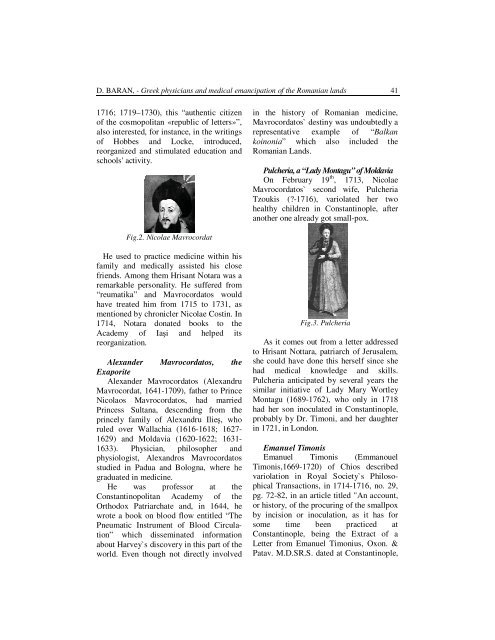Series VI: Medical Sciences – SUPPLEMENT ... - Krongres
Series VI: Medical Sciences – SUPPLEMENT ... - Krongres
Series VI: Medical Sciences – SUPPLEMENT ... - Krongres
You also want an ePaper? Increase the reach of your titles
YUMPU automatically turns print PDFs into web optimized ePapers that Google loves.
D. BARAN, - Greek physicians and medical emancipation of the Romanian lands 41<br />
1716; 1719<strong>–</strong>1730), this “authentic citizen<br />
of the cosmopolitan «republic of letters»”,<br />
also interested, for instance, in the writings<br />
of Hobbes and Locke, introduced,<br />
reorganized and stimulated education and<br />
schools' activity.<br />
Fig.2. Nicolae Mavrocordat<br />
He used to practice medicine within his<br />
family and medically assisted his close<br />
friends. Among them Hrisant Notara was a<br />
remarkable personality. He suffered from<br />
“reumatika” and Mavrocordatos would<br />
have treated him from 1715 to 1731, as<br />
mentioned by chronicler Nicolae Costin. In<br />
1714, Notara donated books to the<br />
Academy of Ia�i and helped its<br />
reorganization.<br />
Alexander Mavrocordatos, the<br />
Exaporite<br />
Alexander Mavrocordatos (Alexandru<br />
Mavrocordat, 1641-1709), father to Prince<br />
Nicolaos Mavrocordatos, had married<br />
Princess Sultana, descending from the<br />
princely family of Alexandru Ilie�, who<br />
ruled over Wallachia (1616-1618; 1627-<br />
1629) and Moldavia (1620-1622; 1631-<br />
1633). Physician, philosopher and<br />
physiologist, Alexandros Mavrocordatos<br />
studied in Padua and Bologna, where he<br />
graduated in medicine.<br />
He was professor at the<br />
Constantinopolitan Academy of the<br />
Orthodox Patriarchate and, in 1644, he<br />
wrote a book on blood flow entitled “The<br />
Pneumatic Instrument of Blood Circulation”<br />
which disseminated information<br />
about Harvey`s discovery in this part of the<br />
world. Even though not directly involved<br />
in the history of Romanian medicine,<br />
Mavrocordatos` destiny was undoubtedly a<br />
representative example of “Balkan<br />
koinonia” which also included the<br />
Romanian Lands.<br />
Pulcheria, a “Lady Montagu” of Moldavia<br />
On February 19 th , 1713, Nicolae<br />
Mavrocordatos` second wife, Pulcheria<br />
Tzoukis (?-1716), variolated her two<br />
healthy children in Constantinople, after<br />
another one already got small-pox.<br />
Fig.3. Pulcheria<br />
As it comes out from a letter addressed<br />
to Hrisant Nottara, patriarch of Jerusalem,<br />
she could have done this herself since she<br />
had medical knowledge and skills.<br />
Pulcheria anticipated by several years the<br />
similar initiative of Lady Mary Wortley<br />
Montagu (1689-1762), who only in 1718<br />
had her son inoculated in Constantinople,<br />
probably by Dr. Timoni, and her daughter<br />
in 1721, in London.<br />
Emanuel Timonis<br />
Emanuel Timonis (Emmanouel<br />
Timonis,1669-1720) of Chios described<br />
variolation in Royal Society`s Philosophical<br />
Transactions, in 1714-1716, no. 29,<br />
pg. 72-82, in an article titled "An account,<br />
or history, of the procuring of the smallpox<br />
by incision or inoculation, as it has for<br />
some time been practiced at<br />
Constantinople, being the Extract of a<br />
Letter from Emanuel Timonius, Oxon. &<br />
Patav. M.D.SR.S. dated at Constantinople,


